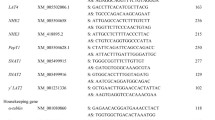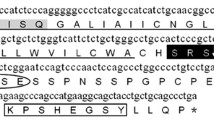Abstract
Dietary glutamate is extensively oxidized in enterocytes during its trans-cellular journey from the intestinal lumen to the blood. This corresponds to high energy requirement for the absorptive function and renewal of the epithelium. Excitatory amino acid carrier 1 (EAAC1) is known to be the major transporter of glutamate in the intestine. The present study was conducted in Huanjiang mini-piglets which represent a valuable agronomical model for pig production and also extrapolation to human intestinal physiology in order: (i) to determine the amino acid sequence of EAAC1; (ii) to measure the ontogenic expression profiles of jejunal EAAC1 during the suckling period and (iii) to evaluate the influence of low body weight at birth on the expression of EAAC1. For such a purpose, we cloned EAAC1 from Huanjiang mini-pig and used real-time RT-PCR method and Western blotting analysis. Our results show that EAAC1 in the mini-pig encoded a predicted 524-AA protein with eight putative trans-membrane domains. The expression in mRNA and protein of EAAC1 in jejunum was increasing from birth up to 14 days of age and then decreased at 21 days. Piglets with small BW had lower jejunal EAAC1 protein content between birth and after 7 days suckling. These findings indicate that the expression of the EAAC1 in jejunum is much depending on the stage of piglet development and that low BW at birth is associated with lower expression of this carrier in the early suckling period. Then, it can be hypothesized that lower expression of the intestinal glutamate carrier may decrease the availability of glutamate to enterocytes, thus challenging the optimal absorptive function of the small intestine and normal mucosal growth.






Similar content being viewed by others
Abbreviations
- AA:
-
Amino acid
- EAAC1:
-
Excitatory amino acid carrier 1
- LBW:
-
Large body weight
- SBW:
-
Small body weight
- IUGR:
-
Intrauterine growth retardation
References
Milligan BN, Dewey CE, de Grau AF (2002) Neonatal-piglet weight variation and its relation to pre-weaning mortality and weight gain on commercial farms. Prev Vet Med 56:119–127
Rehfeldt C, Kuhn G (2006) Consequences of birth weight for postnatal growth performance and carcass quality in pigs as related to myogenesis. J Anim Sci 84:113–123
Wu GY, Bazer FW, Wallace JM, Spencer TE (2006) Intrauterine growth retardation: implications for the animal sciences. J Anim Sci 84:2316–2337
Xu RJ, Mellor DJ, Birtles MJ, Reynolds GW, Simpson HV (1994) Impact of intrauterine growth retardation on the gastrointestinal tract and the pancreas in newborn pigs. J Pediatr Gastroenterol Nutr 18:231–240
Wang T, Huo YJ, Shi F, Xu RJ, Hutz RJ (2005) Effects of intrauterine growth retardation on development of the gastrointestinal tract in neonatal pigs. Biol Neonate 88:66–72
Morise A, Louveau I, Le Huërou-Luron I (2008) Growth and development of adipose tissue and gut and related endocrine status during early growth in the pig: impact of low birth weight. Animal 2:73–83
Widdowson EM, Crabb DE (1976) Changes in the organs of pigs in response to feeding for the first 24 h after birth. Biol Neonate 28:261–271
Blachier F, Boutry C, Bos C, Tomé D (2009) Metabolism and functions of l-glutamate in the epithelial cells of the small and large intestines. Am J Clin Nutr 90:814S–821S
Reeds PJ, Burrin DG, Stoll B, Jahoor F (2000) Intestinal glutamate metabolism. J Nutr 9:S78–S82
Chen LX, Yin YL, Jobgen WS, Jobgen SC, Knabe DA, Hu WX, Wu GY (2007) In vitro oxidation of essential amino acids by jejunal mucosal cells of growing pigs. Livest Sci 109:19–23
Chen LX, Li P, Wang JJ, Li XL, Gao HJ, Yin YL, Hou YQ, Wu GY (2009) Catabolism of nutritionally essential amino acids in developing porcine enterocytes. Amino Acids 37:143–152
Vaugelade P, Posho L, Darcy-Vrillon B, Bernard F, Morel MT, Duée PH (1994) Intestinal oxygen uptake and glucose metabolism during nutrient absorption in the pig. Proc Soc Exp Biol Med 207:309–316
Stoll B, Burrin DG (2006) Measuring splanchnic amino acid metabolism in vivo using stable isotopic tracers. J Anim Sci 84:E60–E72
Burrin DG, Janeczko MJ, Stoll B (2008) Emerging aspects of dietary glutamate metabolism in the developing gut. Asia Pac J Clin Nutr 17(Suppl 1):368–371
Reeds PJ, Burrin DG, Stoll B, Jahoor F, Wykes L, Henry J, Frazer ME (1997) Enteral glutamate is the preferential source for mucosal glutathione synthesis in fed piglets. Am J Physiol 273:E408–E415
Burrin DG, Stoll B (2009) Metabolic fate and function of dietary glutamate in the gut. Am J Clin Nutr 90:S850–S856
Fan MZ, Matthews JC, Etienne NM, Stoll B, Lackeyram D, Burrin DG (2004) Expression of apical membrane l-glutamate transporters in neonatal porcine epithelial cells along the small intestinal crypt-villus axis. Am J Physiol Gastrointest Liver Physiol 287:G385–G398
Iwanaga T, Goto M, Watanabe M (2005) Cellular distribution of glutamate transporters in the gastrointestinal tract of mice: an immunohistochemical and in situ hybridization approach. Biomed Res 26:271–278
Yang HS, Fu DZ, Shao H, Kong XF, Wang WC, Yang XJ, Nyachoti CM, Yin YL (2012) Impacts of birth weight on plasma, liver and skeletal muscle neutral amino acid profiles and intestinal amino acid transporters in suckling Huanjiang mini-piglets. PLoS One 7(12):e50921
Wang WC, Blachier F, Fu DZ, Pan J, Yang HS, Guo JP, Chu WY, Kong XF, Yin YL (2013) Ontogenic expression of the amino acid transporter b°,+ in suckling Huanjiang piglets: effect of intrauterine growth restriction. Br J Nutr. doi:10.1017/S0007114512005843
Kong XF, Wu GY, Liao YP, Hou ZP, Liu HJ, Yin FG, Li TJ, Huang RL, Zhang YM, Deng D, Kang P, Wang RX, Tang ZY, Yang CB, Deng ZY, Xiong H, Chu WY, Ruan Z, Xie MY, Yin YL (2007) Effects of Chinese herbal ultra-fine powder as a dietary additive on growth performance, serum metabolites and intestinal health in early-weaned piglets. Livest Sci 108:272–275
Kong XF, Wu GY, Liao YP, Hou ZP, Liu HJ, Yin FG, Li TJ, Huang RL, Zhang YM, Deng D, Xie MY, Deng ZY, Xiong H, Ruan Z, Kang P, Yang CB, Yin YL, Fan MZ (2007) Dietary supplementation with Chinese herbal ultra-fine powder enhances cellular and humoral immunity in early-weaned piglets. Livest Sci 108:94–98
Wang WC, Shi CY, Zhang JS, Gu WT, Li TJ, Geng MM, Chu WY, Huang RL, Liu YL, Hou YQ, Li P, Yin YL (2009) Molecular cloning, distribution and ontogenetic expression of the oligopeptide transporter PepT1 mRNA in Tibetan suckling piglets. Amino Acids 37:593–601
Yang HS, Li FN, Kong XF, Yuan XX, Lian GQ, Geng MM, Li TJ, Yin JD, Yin YL (2012) Molecular cloning, tissue distribution and ontogenetic expression of Xiang pig chemerin and its involvement in regulating energy metabolism through Akt and ERK1/2 signaling pathways. Mol Biol Rep 39:1887–1894
Luo G, Zhang L, Liu LS, Li Y, Wei H, Yuan J (2004) The applied research prospects of laboratory mini-pig in China. Lab Anim Sci Manag 21:37–38
Bollen P, Ellegaard L (1997) The Gottingen minipig in pharmacology and toxicology. Pharmacol Toxicol 80:3–4
Zhao DS (2008) Characteristic and feeding management of fragrant pigs. Livest Poult Husb 3:16–17
Yao SK, Zhang Q, Sun FZ, Liu PQ (2006) Genetic diversity of seven miniature pig breeds (strains) analyzed by using microsatellite markers. Yi Chuan 28:407–412
Wang XL, Wu KL, Li N, Li CL, Qiu XM, Wang AH, Wu CX (2006) Analysis of expressed sequence tags from skeletal muscle-specific cDNA library of Chinese native Xiang pig. Yi Chuan Xue Bao 33:984–991
Yuan B, Zhang YR, Zhao Z, Wu DL, Yuan LZ, Wu B, Wang LS, Huang J (2008) Treatment of chronical myocardial ischemia by adenovirus-mediated hepatocyte growth factor gene transfer in mini-pigs. Sci China C Life Sci 51:537–543
Zhang M, Jing RB, Cui HB (1996) The investigation of growth development, reproductive characteristics and experimental animalization in fragrant pigs. Swine Prod 2:30–32
Kanai Y, Stelzner M, Nussberger S, Khawaja S, Hebert SC, Smith CP, Hediger MA (1994) The neuronal and epithelial human high affinity glutamate transporter. J Biol Chem 296:20599–20606
Zimin AV, Delcher AL, Florea L, Kelley DR, Schatz MC, Puiu D, Hanrahan F, Pertea G, Van Tassell CP, Sonstegard TS, Marçais G, Roberts M, Subramanian P, Yorke JA, Salzberg SL (2009) A whole-genome assembly of the domestic cow Bos taurus. Genome Biol 10:R42
Tanaka K (1993) Cloning and expression of a glutamate transporter from mouse brain. Neurosci Lett 159:183–186
Bjørås M, Gjesdal O, Erickson JD, Torp R, Levy LM, Ottersen OP, Degree M, Storm-Mathisen J, Seeberg E, Danbolt NC (1996) Cloning and expression of a neuronal rat brain glutamate transporter. Mol Brain Res 36:163–168
Pagni M, Ioannidis V, Cerutti L, Zahn-Zabal M, Jongeneel CV, Hau J, Martin O, Kuznetsov D, Falquet L (2007) MyHits: improvements to an interactive resource for analyzing protein sequences. Nucleic Acids Res 35:W433–W437
Winona CB, John SG, Huang HZ, Peter BM, Bruce CO, Geetha YS, Xiao CL, Yeh LL, Robert SL, Joseph FJ, Friedhelm P, Hans-Werner M, Akira T, Wu C (2000) The protein information resource (PIR). Nucleic Acids Res 28:41–44
Möller S, Croning MD, Apweiler R (2001) Evaluation of methods for the prediction of membrane spanning regions. Bioinformatics 17:646–653
Gegelashvili G, Schousboe A (1997) High affinity glutamate transporters: regulation of expression and activity. Mol Pharmacol 52:6–15
Casado M, Bendahan A, Zafra F, Danbolt NC, Aragon C, Gimenez C, Kanner BI (1993) Phosphorylation and modulation of brain glutamate transporters by protein kinase C. J Biol Chem 268:27313–27317
Hertz L, Bock E, Schousboe A (1978) GFA content, glutamate uptake and activity of glutamate metabolizing enzymes in differentiating mouse astrocytes. Dev Neurosci 1:226–238
D’Inca R, Kloareg M, Gras-Le Guen C, Le Huërou-Luron I (2010) Intrauterine growth restriction modifies the developmental pattern of intestinal structure, transcriptomic profile, and bacterial colonization in neonatal pigs. J Nutr 140:925–931
Blachier F, Guihot-joubrel G, Vaugelade P, Le Boucher J, Bernard F, Duée PH, Cynober L (1999) Portal hyperglutamatemia after dietary supplementation with monosodium glutamate in pigs. Digestion 60:349–357
Newsholme P, Procopio J, Lima MM, Pithon-Curi TC, Curi R (2003) Glutamine and glutamate-their central role in cell metabolism and function. Cell Biochem Funct 21:1–9
Da Silva-Buttkus P, van den Hurk R, Velde ERT, Taverne MAM (2003) Ovarian development in intrauterine growth-retarded and normally developed piglets originating from the same litter. Reprod 126:249–258
Acknowledgments
This study was jointly supported by National Natural Science Foundation of China (No. 30901040 and 31110103909).
Author information
Authors and Affiliations
Corresponding authors
Additional information
Dezhi Fu and Huansheng Yang contributed equally to this work.
Rights and permissions
About this article
Cite this article
Fu, D., Yang, H., Kong, X. et al. Molecular cloning and expression profiling of excitatory amino acid carrier 1 in suckling Huanjiang mini-piglets with large or small body weight at birth. Mol Biol Rep 40, 3341–3350 (2013). https://doi.org/10.1007/s11033-012-2409-y
Received:
Accepted:
Published:
Issue Date:
DOI: https://doi.org/10.1007/s11033-012-2409-y




